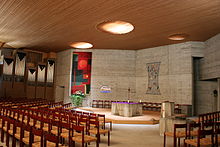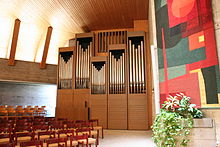St. Martin (Seuzach)
The Church of St. Martin is the Roman Catholic parish church of Seuzach in the Zurich district of Winterthur . It is at Reutlingerstrasse 52 . The parish belonging to it is responsible for the places Altikon , Dägerlen , Dinhard , Hettlingen ZH , Thalheim and Seuzach.
history
History and naming
The medieval church of Seuzach was consecrated on June 26th 1131 by Ulrich II of Constance “in honor of our Lord Jesus Christ and the holy cross and the holy virgin Mary, mother of God and holy Martin and all saints”, as in one Certificate from the time is called. This church was a small Romanesque building with a rectangular hall, gable roof and turret . In 1497 this church received a polygonal choir . When the Reformation was carried out in Zurich in 1524 , Reformed services were held in the Seuzach church from 1525. The Catholic cult was banned in the area of today's Canton of Zurich until the 19th century. The Edict of Tolerance of 1807 allowed a Catholic worship service in the canton of Zurich for the first time, but only in the city of Zurich. In 1813, 50 Catholics residing in the city of Winterthur appealed to the city fathers for tolerance , but it was not until 1862, when the Rheinau monastery was abolished and the further use of its property was legally regulated by the canton of Zurich, that the first Catholic service was allowed in Winterthur have taken place since the Reformation. The so-called First Zurich Church Law from 1863 recognized Zurich as well as the Catholic parishes in Winterthur, Rheinau and Dietikon (the last two were traditionally Catholic places), so that a Catholic parish could be established in Winterthur. In 1868 the newly built St. Peter and Paul Church was opened in the presence of representatives of the cantonal government, including state clerk and poet Gottfried Keller, and the city council of Winterthur. However, the establishment of further parishes in the canton was not recognized by the state, which is why these had to be set up on the basis of private and association law.
Development and construction history
In the course of industrialization , working-class families from Catholic countries moved to the canton of Zurich. Since the Catholic churches in the traditionally reformed canton had only occasionally settled down, long distances had to be covered for the worship service. The Catholic residents of the communities northeast of Winterthur were looked after by the parish of St. Marien Oberwinterthur . When the desire for their own church services grew, a separate pastoral district was set up for the Catholics in the parishes near Rickenbach ZH and Seuzach, which, however, remained affiliated to the parish of St. Marien in Oberwinterthur. In the same year, the first mass in the new pastoral care district was celebrated in the Zur Mühle inn in Rickenbach. When French and Polish soldiers were stationed in Seuzach during the Second World War , Catholic Sunday services were held for them in the hall of the Gasthaus Linde , to which the Catholic residents of Seuzach were also invited. After the soldiers left Seuzach, the desire arose to continue celebrating Catholic services. For this reason, a first chapel was set up in the garage of the Meier plumber's shop on Stationsstrasse , in which regular services were held from 1942. In 1956 the building site for the church St. Josef (Rickenbach-Sulz) was bought. There the Catholics built the church with a lot of personal effort in the years 1957-1958, which was consecrated in 1958. In 1959, the St. Martin Foundation, Seuzach was established for the acquisition of the building plot on Reutlingerstrasse in Seuzach. After the state recognition of the Catholic Church in the canton of Zurich in 1963, the Catholic parish of Rickenbach-Seuzach was formed with the political communities Altikon, Bertschikon , Dägerlen, Dinhard, Ellikon , Elsau , Hettlingen, Rickenbach, Seuzach, Thalheim and Wiesendangen . The St. Josef Foundation was founded in 1966 to promote pastoral care, church services, religious instruction and charitable interests in Sulz-Rickenbach . In 1968 the Rickenbach-Seuzach parish rectorate was set up, which remained attached to the St. Marien parish in Oberwinterthur. On July 3, 1971, the foundation stone of the St. Martin Church in Seuzach was laid, which was built according to the plans of the architects Robert Tanner and Felix Loetscher . The bishop of Chur , Johannes Vonderach , consecrated the completed church on July 2, 1972. In the same year, St. Martin in Seuzach and St. Josef in Sulz-Rickenbach were raised to separate parishes and separated from St. Marien Oberwinterthur.
The parish of St. Stefan Wiesendangen belongs together with the parish of St. Martin Seuzach to the common parish. With 5,936 members (as of 2017), this is one of the larger Catholic parishes in the Canton of Zurich.
Building description and artistic equipment
Church tower and exterior
The parish gave itself the St. Martin statue on the church square for the 25th anniversary. The artist Werner Ignaz Jans has transferred "Saint Martin" into our time. The beggar sits on the edge of the pedestal, almost falls out of society. He stands for the unemployed, old people, refugees, drug addicts - they are all freezing. Saint Martin shows mercy . He has stepped down from the horse in the Seuzach coat of arms and gives the beggar cloak and protection. For his good deed, St. Martin experiences the happiness of giving. The goose from the Martin legend rounds off the picture. "
The free-standing bell tower houses a four-part bell:
| number | Weight | diameter | volume | dedication | inscription |
|---|---|---|---|---|---|
| 1 | 1340 kg | 1350 mm | it 1 | St. Martin | "If God loved us so much, then we too must love one another" |
| 2 | 712 kg | 1070 mm | g 1 | Brother Klaus | "Be joyful in hope, be patient in tribulation and persevere in prayer" |
| 3 | 400 kg | 890 mm | b 1 | Mother of God | "Blessed are you that you believed" |
| 4th | 285 kg | 790 mm | c 2 | Guardian Angel | "He's on my right so that I don't waver" |
Interior and artistic equipment
The church building project on Reutlingerstrasse began in 1968 with an architectural competition that was won by the architects Tanner and Loetscher. The church itself and the artistic design by the artist Ro Studer-Koch are to be viewed as a complete work. In this context, the material concrete has a significant expressiveness in its peculiarity.
The aim was to show the inner dependence of architecture and art and to avoid anything monumental . Space and form are subordinate to the respective events. The tabernacle wall , as a powerfully structured, bundled pillar, carries the volume above the prayer room. The tabernacle wall emphasizes the upward movement through the relief from floor to ceiling. This relief symbolizes Jacob's ladder , a motif that the artist Ro Studer-Koch also picked up on the tabernacle wall in St. Petrus Church in Embrach . The Jacob's ladder, "which Jacob saw in a dream, allows both the ascent into higher spheres and the return to earth." The tabernacle is hidden in a prayer niche in the tabernacle wall and is made of bronze . The altar and ambo were also created by Ro Studer-Koch and, made of concrete, form the center of the church space. The baptismal font - also a work by Ro Studer-Koch - takes up the design language of the altar and contains a baptismal font made from faience (glazed earthenware ) by Robert Schoffat . This faience shows a sprout in which the cross can be guessed. The baptismal font is closed by a lid, which, with its cubic elements, relates to the interior design of Ro Studer-Koch. The twelve individually shaped bronze crosses on the wall near the baptismal font also come from her. These apostle crosses symbolize the twelve disciples of Jesus. The lecture cross in the chancel was made by Josef Caminada . It takes up the colors of the large tapestry that was specially created by Ro Studer-Koch for this church room. The tapestry sets a strong color accent in the room determined by the concrete. The tapestry was created instead of a figure of Mary and refers to the Christmas theme , in particular to the way to Bethlehem and the birth in the stable. For Ro Studer-Koch, this tapestry is a symbol of “being on the move. The small pale yellow square symbolizes the light that was brought into the darkness at Christmas. ”The play of shapes and colors should convey the good news“ Christ was born, Mary gave us the Redeemer, the light of the world ”.
A copy of the Krumlov Madonna was purchased in 1983. It is carved in linden wood and painted with gold leaf. The original - a stone carving from around 1400 in South Bohemia (Krumau / Český Krumlov ) is now in the Art History Museum in Vienna. The master of the Krumlov Madonna is the Gothic sculptor who created the figure of Mary with baby Jesus in Bohemia around 1390 or 1400. Originally known as the Krumlov Madonna, this colored sculpture made of sand-lime brick was discovered in 1910 in a private house in the South Bohemian city of Krumlov, and that's how it got its name. After this only firmly assigned work, the not known master of the Krumlov Madonna was given his emergency name.
organ
The organ of the St. Martin church was built in 1972 by the company X. Mönch Söhne from Überlingen / Bodensee, today: Mönch Orgelbau Überlingen. Mark Wagenbach, organ builder from Seuzach, has been looking after the organ since the 1990s. It is a two- manual instrument with a pedal, 17 registers , mechanical action , electrical register switching and two free combinations .
|
|
|
||||||||||||||||||||||||||||||||||||||||
- Coupling : II / I, I / P, II / P
literature
- Episcopal Ordinariate Chur (ed.): Schematism of the Diocese of Chur. Chur 1980.
- Art Association Ro Studer-Koch (Ed.): Ro Studer Koch. A guide to public works in and around Winterthur. Berlin 1997.
Web links
Individual evidence
- ^ Archives of the parish of St. Martin: Chronicle of Seuzach. Pp. 43-44.
- ↑ Episcopal Ordinariate Chur (ed.): Schematism of the Diocese of Chur. P. 250.
- ^ Peter Niederhäuser and Flurina Pescatore: St. Peter and Paul. The mother church of Katholisch-Winterthur. Pp. 7-17.
- ↑ a b Website of the parish of St. Stefan, section history. ( Memento from May 2, 2014 in the Internet Archive )
- ↑ Guido Hayoz: From the parish history of St. Martin Seuzach.
- ↑ Catholic Church in the Canton of Zurich (Ed.): Annual Report 2017. p. 84.
- ↑ a b Website of the parish of St. Martin Seuzach, section Architecture and Art in St. Martin. ( Memento from July 23, 2013 in the Internet Archive )
- ^ A b Art Association Ro Studer-Koch (Ed.): Ro Studer Koch. A guide to public works in and around Winterthur. P. 14.
- ^ Archives of the parish.
Coordinates: 47 ° 31 '55.7 " N , 8 ° 44' 9.6" E ; CH1903: 697691 / 265 408















